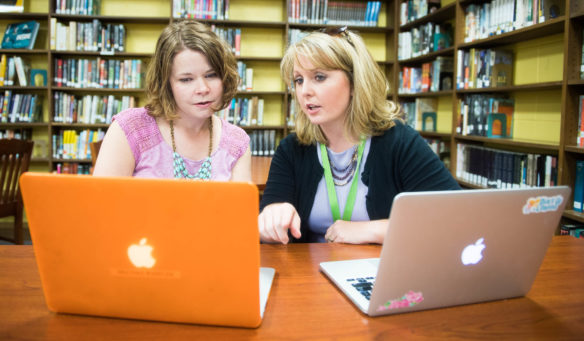
Stephanie Wade, right, the technology integration specialist for Boyle County schools, works with Heather Wheeler, a Spanish teacher at Boyle County High School, on Flipgrid, a program Wheeler uses to help her students submit assignments. Wade filled a newly created position in 2014 in which she collaborates with teachers to help them better use instructional software and network resources. Boyle County has since enlisted other teachers and library media specialists to assist her.
Photo by Bobby Ellis, May 18, 2017
By Mike Marsee
michael.marsee@education.ky.gov
Getting technology into the hands of students is important, but it doesn’t necessarily mean those devices are being used effectively in class.
When the Boyle County school district began implementing a 1-to-1 technology initiative, administrators soon saw a need for people who could help teachers make the most of the resources they had been given.
“As our district started getting devices into the hands of students, they quickly realized having that technology required instruction to change,” said Stephanie Wade, the district’s technology integration specialist.
Wade filled a newly created position in 2014 in which she helps collaborate with teachers in the district’s five schools to help them better use instructional software and network resources. Boyle County has since enlisted library media specialists and Google-certified teachers to assist her.
“We’re trying to build an army,” Wade said.
Boyle County has been among the leaders in helping teachers implement technology in the classroom, but fewer school districts have the people necessary to coach teachers or even to keep the technology in working order.
Marty Park, the chief digital officer in the Kentucky Department of Education’s (KDE) Office of Education Technology, calls it “human capital.” He said more of it is needed to ensure that students get the full use of the technology available to them – and even to avoid a scenario in which there are stacks of unused or underused devices.
“In the past decade we’ve seen an explosion of the integration of digital tools and resources in the classroom, as well as technology-enabled services in schools,” said Park. “As we digitize more and integrate technology more, the gap of technology tools and services and the number of people to support and teach and coach on those continues to widen. We’ve watched this over the last several years.”
KDE issued a call to action for districts at the Kentucky Society for Technology in Education (KySTE) conference earlier this year, saying districts need to provide better support for the technology teachers and students are using.
“It can’t just be about the technology. We would never promote technology just for the sake of it,” Park said. “It’s always got to be about learning and implementation, and also the impact on improved learning.”
Sixty-six of Kentucky’s 173 school districts – 38 percent – have implemented 1-to-1 technology initiatives, which refer to the ratio of technology devices to students, teachers and administrators.
In the 2015 TELL (Teaching, Empowering, Leading and Learning) Kentucky survey of educators, 4 of 5 teachers said they had access to technology, but just 2 of 5 said they had access to technology specialists to help them figure out how to work it into their classrooms.
More districts are adding technology integration specialists or digital learning coaches, but Park said there is more to be done.
“It’s to a point where we’re considering it a crisis,” he said.
KDE has developed a model through which districts can get a better handle on the roles they need to fill based on its six pillars of success in educational technology:
- Operations
- Instructional alignment and integration
- Financial, ethical and policy leadership
- Data and information management and security and strategies
- Strategic planning
- Emerging technology and innovation
“We’re being very careful to say it’s a model, it’s not a mandated formula,” Park said. “We have districts in the state that are very successful, so we’ve looked at those. We’ve also looked at some outside research.
“We’re saying, ‘Look at your average daily attendance and the current devices you have, and that should give you some type of framework based on the six pillars.”
The model spells out the need for the roles a chief information officer, a data administrator, a lead technology person – such as a chief technology officer or network administrator – technicians and digital learning coaches or technology integration specialists.
Park said the model was born out of conversations with superintendents, some of whom said they have no formula for technology support roles and positions, and others whose technology staff is ineffective because too few people are asked to do too much.
He said technology integration specialists such as Wade are only part of the picture, but they are an important part. “If that’s not there, then we see a big investment that isn’t maximized,” Park said.
Wade, a former library media specialist at Boyle County High School, moved into her new role three years ago.
“I’m basically a resource for the teachers, trying to equip people in the school buildings, people that are there every day in the trenches,” she said. “We have a really good team of teachers and a good technology staff, so that is really helpful.”
Before Wade’s position was created at Boyle County, Susan Taylor, the district’s chief technology officer, filled a number of roles that are now divided among several people.
“When we went 1-to-1, we realized it was a rat race covering all five schools with devices all the way down to 4th grade,” Wade said. “We knew we had to start equipping people in the schools.”
One natural place to start was with the library media specialists, who have become a go-to for instructional technology in their schools.
The district also has made it a priority to have at least one Google-certified teacher in each building who can assist colleagues with G Suite for Education. Five teachers have achieved Level 1 certification, and by next school year, three teachers will have reached Level 2.
“I’d love to say we’ll have more integration specialists in the district someday, but if that doesn’t happen, then we have more people in the schools,” Wade said. “That’s important, because we’ve gone from teachers having to know just content to having to know content and delivery with technology.”
Boyle County’s team also includes two network technicians.
“Years ago when the internet went down, it would have been an inconvenience; now it stops instruction,” Wade said. “The majority of things the teachers have planned in their classrooms involve technology.”
Wade said the district has taken care to listen to what those teachers say they need and what they say is working well.
“One of the biggest discoveries was that the effective use of technology definitely increases engagement in our students. We’ve had 1-to-1 for two years, and our scores on our assessments have continued to go up,” she said.
Like Wade, Whitney York became the technology integration specialist in the Murray Independent district three years ago, although this is only the second year that has been a full-time position.
York trains teachers on the software they’re using and makes herself available when questions or issues arise.
“I’m still a teacher at heart and I have really enjoyed helping our teachers in this way,” York said.
Murray Independent has not implemented a 1-to-1 initiative, but the number of devices being used in the district continues to increase.
“Because of that, we need more support,” York said. “Teachers want to be able to use what they have available to them, but they often don’t have time to figure out how to use it themselves.”
Park said KDE is using districts such as Boyle County and Murray Independent as an illustration of what can happen when schools make the most of their investment in technology.
“It boils down to, ‘Are kids getting to use the stuff?’” he said.
MORE INFO …
Marty Park marty.park@education.ky.gov
Stephanie Wade stephanie.wade@boyle.kyschools.us
Whitney York whitney.york@murray.kyschools.us




Leave A Comment